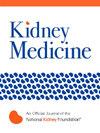艾伯塔省2009-2018年住院急性肾损伤的时间趋势:一项基于人群的回顾性队列研究
IF 3.4
Q1 UROLOGY & NEPHROLOGY
引用次数: 0
摘要
基本原理及研究报告了急性肾损伤(AKI)发生率的增加;但是,它们受到行政法规的限制。我们的目的是使用基于肾脏疾病:改善全球结局(KDIGO)的定义来确定AKI发病率、严重程度和死亡率的趋势。研究设计:这是一项基于人群的回顾性队列研究。设置,2009-2018年加拿大艾伯塔省住院的成年患者。使用经过验证的KDIGO定义确定暴露性aki发作。结果:我们评估了住院死亡率和90天全因死亡率。分析方法采用高斯族广义线性模型来确定AKI的绝对发生率和死亡率。AKI和死亡率根据患者人口统计学和合并症进行调整。结果有339,986例AKI住院(12.7%,2,668,954例住院),中位年龄为70岁(56,82例),女性152,115例(44.7%)。AKI发生率增加了5.5%(95%可信区间[CI], 4.2-6.9)。完全调整后,AKI发生率相对下降11.2% (95% CI, 9.2-13.2)。1期AKI最为常见(未经调整的平均发生率为659 / 100,000人-年[95% CI, 655-662])。住院死亡率在AKI的所有阶段均有所下降,其中需要肾脏替代治疗的3期AKI下降幅度最大(未经调整的相对下降29.9% [95% CI, 20-38.6])。在90天死亡率中发现了类似的趋势。这篇论文的主要优势在于它涉及了来自不同人群的大量患者。KDIGO定义AKI的使用受限于对血清肌酐值的依赖。结论:尽管AKI的发生率似乎在增加,但这似乎主要是由患者合并症引起的,其中1期AKI的发生率最高。此外,在粗数据和调整后的数据中,60岁以下患者的AKI发生率总体上升,而大多数老年患者的AKI发生率下降,这表明实践模式和患者特征可能发生变化。尽管死亡率有所增加,但总体上死亡率有所下降,特别是在严重形式的AKI中。急性肾损伤(acute kidney injury, AKI)是指肾功能的突然下降。它很常见,据报道在文献中正在增加;然而,先前的研究受到AKI定义的限制。在这项研究中,我们研究了2009年至2018年加拿大阿尔伯塔省AKI住院患者中AKI数量和死亡率的变化。我们发现,当我们考虑到病人病情加重的事实时,除了60岁及以下的人之外,所有人的AKI发病率都在下降。尽管如此,随着时间的推移,AKI患者的死亡人数减少了。本文章由计算机程序翻译,如有差异,请以英文原文为准。
Temporal Trends in Acute Kidney Injury in Hospitalizations From 2009-2018 in Alberta: A Retrospective Population-Based Cohort Study
Rationale & Objective
Studies have reported an increase in acute kidney injury (AKI) incidence; however, they are limited by administrative codes. We aimed to identify trends in AKI incidence, severity, and mortality using Kidney Disease: Improving Global Outcomes (KDIGO)-based definitions.
Study Design
This is a retrospective, population-based cohort study.
Setting & Population
Hospitalized adult patients in Alberta, Canada from 2009-2018.
Exposures
AKI episodes were identified using validated KDIGO definitions.
Outcomes
We assessed in-hospital and 90-day all-cause mortality.
Analytical Approach
Generalized linear models with a Gaussian family were used to determine absolute rates of AKI and mortality. Rates of AKI and mortality were adjusted for patient demographics and comorbid conditions.
Results
There were 339,986 hospitalizations with an episode of AKI (12.7%, 2,668,954 hospitalizations) with a median age of 70 years (56, 82) and 152,115 (44.7%) women. AKI rates increased by an unadjusted relative increase of 5.5% (95% confidence interval [CI], 4.2-6.9). When fully adjusted, a relative decrease of 11.2% (95% CI, 9.2-13.2) was seen in rates of AKI. Stage 1 AKI was most common (unadjusted mean rate, 659 per 100,000 person-years [95% CI, 655-662]). In-hospital mortality decreased across all stages of AKI with the greatest decrease noted in stage 3 AKI requiring kidney replacement therapy (unadjusted relative decrease 29.9% [95% CI, 20-38.6]). Similar trends were identified in 90-day mortality.
Limitations
The primary strength of this paper is that it involves a large cohort of patients from a diverse population. The use of KDIGO definition of AKI is limited by the reliance on serum creatinine values.
Conclusions
Although rates of AKI appear to be increasing, this seems to be largely driven by patient comorbid condition with the highest rates seen in stage 1 AKI. Furthermore, there was an overall increase in rates of AKI in patients aged younger than 60 and a decrease in the most elderly of patients in both the crude and adjusted data, suggesting potential changes in practice patterns and patient characteristics. Despite this increase, there was an overall decrease in mortality, especially in severe forms of AKI.
Plain Language Summary
Acute kidney injury (AKI) is the sudden decrease in kidney function. It is common and reported to be increasing in the literature; however, previous studies are limited by their definitions of AKI. In this study, we looked at changes in the number of AKIs and death rates in hospitalized patients with AKI in Alberta, Canada from 2009-2018. We found that when we accounted for the fact that patients are getting sicker, the rates of AKI are decreasing in everyone except people aged 60 and younger. Despite this, people with AKI have experienced less death over time.
求助全文
通过发布文献求助,成功后即可免费获取论文全文。
去求助

 求助内容:
求助内容: 应助结果提醒方式:
应助结果提醒方式:


